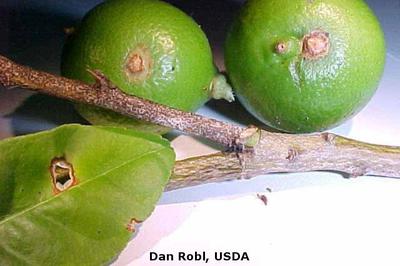Anthracnose of Lime
Glomerella acutata
Fungus
In a Nutshell
- Brown spots on leaves.
- Spots wither and fall out.
- Leaves and young shoots blight and drop.
- Young fruits drop prematurely.
Can also be found in
Symptoms
Lime anthracnose affects flowers, young leaves and fruits, and lesions range from small spots that can expand to cover large areas. Leaves and fruit often shed and twigs are killed, resulting in "withertip" symptoms. Foliar symptoms are visible as necrotic spots that may result in a shot-hole effect if the necrotic areas fall out. In severe infections the leaves and entire young shoots can become totally blighted and drop. In addition, shoot tips may die back and leaf deformation may occur. Infection of young fruit usually results in premature fruit drop. Late infections produce lesions that are often large and deep and accompanied by fruit distortion.
Recommendations

Organic Control
Sorry, we don't know of any alternative treatment against Glomerella acutata . Please get in touch with us in case you know of something that might help to fight this disease. We are looking forward to hearing from you.

Chemical Control
Always consider an integrated approach with preventive measures together with biological treatments if available. Fungicides based on captan or maneb can provide effective treatment against Glomerella acutata. Start treatment at flowering stage.
What caused it?
The epidemiology of this disease has not been completely studied. Lime anthracnose survives from season to season on dead twigs and in lesions on mature leaves. It only infects young tissues following spore dispersal by water splash. The constant leaf flushing of limes together with the large amount of infectious matter that can be produced on these tissues, make lime anthracnose difficult to control.
Preventive Measures
- Grow resistant varieties if available.
- Use seeds from healthy plants or from certified sources.
- Check seedlings for leaf spots before planting.
- Monitor the orchard regularly for signs of the disease.
- Remove or burn field waste after harvest.
- Ensure sufficient space between lime trees to increase ventilation.



